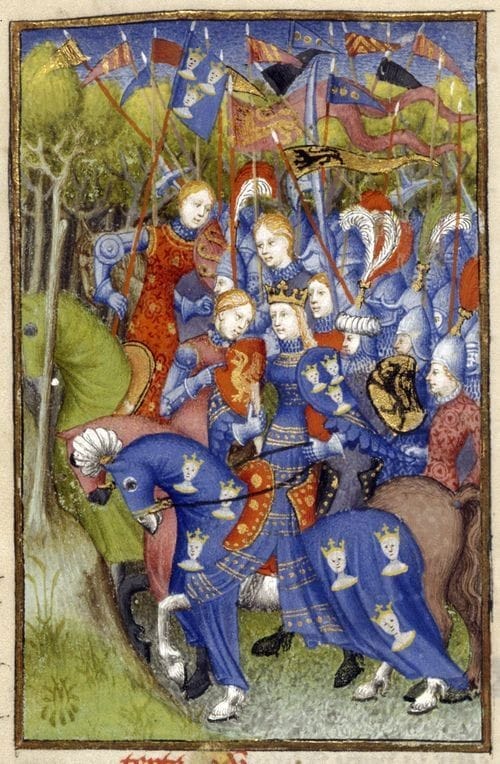
Uno spazio dove si parli e racconti degli usi e costumi del periodo storico di fine XIV secolo: è quanto troverete su lextra.news grazie alla disponibilità, passione e competenza dei componenti dell’associazione Scudo e Spada, già molto attivi sul territorio con attività di didattica, laboratori ed accampamenti medievali.

di Azzurra Guido
curatrice storica “Associazione Scudo e Spada”
Condensare in poche righe il ruolo assunto dalle donne durante il corso del Medioevo, un periodo che, ricordiamo, va dal V al XV secolo, non è così semplice come sembrerebbe.
Il concetto di donna come creatura fragile, da proteggere, non educata, rinchiusa in casa e sottoposta al vincolo di obbedienza del padre prima e del marito poi, è sicuramente quello di maggior successo durante questi secoli che, tuttavia, vedono, contemporaneamente, un’evoluzione eterogenea dello stesso, con risultati sorprendenti.
È risaputo che le donne fossero destinate a sposarsi, ad avere e allevare figli, con l’alternativa sociale di prendere i voti, entrare in convento e riuscire ad acquisire, in questo modo, una formazione culturale e a raggiungere la posizione di potere di badessa. Dedite, anche, ad alcuni tipi di lavori tradizionalmente considerati femminili come l’ostetricia o la filatura, quando appartenenti a famiglie nobiliari e, quindi, presenti nelle corti del tempo, svolsero importanti e delicati ruoli diplomatici di mediazione, esercitando addirittura, quando regine o reggenti, influenze sulle elezioni pontificie.
L’aspetto della vita delle donne forse meno conosciuto, o sul quale viene solitamente fatta meno chiarezza, è se partecipassero o meno a battaglie e guerre: le guerriere del Medioevo sono reali o frutto di fantasia?
Le fonti storiche ed iconografiche confermano che non solo le donne in armi sono effettivamente esistite ma che esse avevano ricevuto anche l’addestramento necessario al combattimento pesante se non, in alcuni casi, una vera e propria investitura come cavalieri. E questa pratica era così diffusa al punto che papa Clemente III emanò una bolla, nel 1189, in cui si proibiva alle donne di indossare abiti maschili e combattere. Armate e volitive, le donne medievali accompagnarono gli eserciti durante le Crociate ed erano così preparate da partecipare anche ai tornei, come ci riporta la British Chronicle del 1348. Sempre del XIV secolo è il manoscritto identificato come I-33 London Tower Fechtbuch, un manuale di addestramento accompagnato da immagini, in cui è rappresentata la guerriera Walpurgis.
Esistevano ordini cavallereschi che accoglievano le donne nei loro ranghi; è il caso dell’Ordine dell’Accetta, fondato in Catalogna da Raimondo Berenger per onorare le donne che aveva difeso la città di Tolosa; o l’Ordine della Gloriosa Santa Maria, del 1233 di Lodengo d’Andalo, a Bologna, che ottenne il riconoscimento papale, con il titolo di militissae per le sue componenti.
E le fonti non sono avare di nomi, anche tralasciando i numerosi esempi provenienti dal mondo islamico e dall’Estremo Oriente e concentrandosi sul territorio europeo: da Santa Genoveffa protettrice di Parigi contro gli Unni di Attila alla più famosa di tutte, Giovanna d’Arco, passando per Hlaðgerðr (Lagertha), la leggendaria skjaldmær (fanciulla dello scudo) vichinga e la guerra delle due Giovanne (di Fiandra e di Penthievre) per la successione bretone. Fra le tante, due menzioni in particolare: Sichelgaita di Salerno, del 1036, principessa longobarda andata in sposa, come seconda moglie, a Roberto il Guiscardo, duca di Puglia, donna di grande cultura e dal carattere indomito che combattè in prima linea, durante la battaglia di Durazzo, armata di corazza e alla testa delle truppe, definita dalla storica bizantina Anna Comnena “una seconda Atena”; e Marzia, detta Cia, degli Ubaldini, conosciuta con il cognome del marito, il signore di Forlì Francesco Ordelaffi, nata nel 1317, schierata in favore del partito ghibellino, alla quale si deve la difesa della città di Cesena durante la crociata contro i Forlivesi del 1357 e l’eroica resistenza contro le truppe guelfe che, solo con grande fatica e dispendio di vite umane, riuscirono a farla cedere.
***
Summarising the role played by women during Middle Ages, a period that cames from V to XV century, is certainly not an easy task.The concept of a woman as a fragile creature to protect, not educated, locked in her house and subject to the bond of obedience to her father first hten her husband, was, without a doubt, the most successful during these centuries which, however, saw, at the same time, a heterogeneous evolution of it, with some amazing results.It is well known that women were destined to get married, have and raise children, with the social alternative of taking vows, entering a convent and succeeding to obtain, in this way, a cultural education and to reach the powerful position of Prioress.Dedicated to come activities traditionally regarded as feminine, as midwifery and spinning, when members of noble families and, the, at the courts of that time, thay palyed significant and delicate diplomatic roles of mediation, exercising even an influence in pontifical elections, when queens or rulers.The least known aspect of women life or, maybe, the least clear one, is the possibility of women participating in battles and wars: medieval warrior women are real or a work of fiction?Historical and iconographic sources confirm not only that fighting women have actually existed but also that they had received the necessary training for haevy fighting and, in some cases, a real investiture as knights. And this practice was so widespread that pope Clement III issued an edict, in 1189, in which women were forbidden to wear male clothing and fight.Armed and strong willed, medieval women accompanied armies on the Crusades and they were so prepared to participate in jousts too, as the British Chronicle (1348) reports.We have also a munuscript of the XIV century, identified as I-33 London Tower Fechtbuch, a training manual accompanied by images, where the warrior woman Walpurgis is represented.There were Orders of Chivalry that welcomed women in their ranks, as the Order of the Axe, founded by Raimondo Berenger in Catalunya to honor women who defended the city of Tolosa; or the Order of Glorious Saint Mary, in 1233, by Lodengo d’Andalo, that achieved the promulgation of papal decree with the mane of “militissae” (litt. “soldier women”)for its members.And the sources aren’t stingy with names, even leaving out the many examples from Islamic world and the Far East and focusing only on Europe: from Saint Genevieve patron of Paris against the Huns of Attila to the most famous above all, Joan of Arc, passing by Hlaðgerðr (Lagertha), the legendary viking skjaldmær (shieldmaiden) and the War of the Two Joannas (of Flanders and of Penthievre) for the breton succession. Among the many, two names: Sichelgaita of Salerno, born in 1036, longobard princess who married, as his second wife, Robert Guiscard, duke of Apulia, woman of wide culture and indomitable character who fought on the front lines during Durazzo battle, with armour and at the head of the troops, called by the Byzantin historian Anna Comnena, “the second Athena”; and Marzia, called Cia, degli Ubaldini, well known with the last mane of her husband, the lord of Forlì Francesco Ordelaffi, born in 1317, who, in favour of the Ghibellines, defended the city of Cesena during the Forlivesi Crusade and heroically resisted against the Guelph troops that, only with grat effort and human cost, managed to break her down.
Testi di riferimento
Aldo A. Settia, Rapine, Assedi e Battaglie. La guerra nel Medioevo, Editori Laterza, 2002.
F. Gabrieli (a cura di), Storici arabi alle Crociate, Garzanti Editori, 1983.
F. Cuomo, Gli ordini cavallereschi, Newton&Compton Editori, 2001.
M.C. Erler, M. Kowalesky, Gendering the Master Narrative: Women and Power in the Middle Ages, Cornell University Press, 2003.
De Pawn, L.Grant, Battle Cries and Lullabies: Women in war from Prehistory to the present, University of Oklahoma Press, 1998.
Blythe, James M., Women in the Military: scholastic arguments and medieval images of female warriors, History of Political Thought, 2001.
D. Memoli Apicella, Sichelgaita tra Longobardi e Normanni, Laveglia e Carlone Editore, Salerno, 2009.
Marzia degli Ubaldini Ordelaffi in Enciclopedia Treccani, Istituto dell’Enciclopedia Italiana




